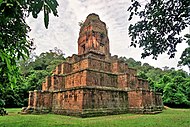The Khmer Empire was one of the most powerful empires in Southeast Asia. The empire, which grew out of the former kingdom of Chenla, at times ruled over and/or vassalized parts of modern-day Laos, Thailand, Vietnam, Burma, and Malaysia. Its greatest legacy is Angkor, in present-day Cambodia, which was the site of the capital city during the empire's zenith. Angkor bears testimony to the Khmer empire's immense power and wealth, as well as the variety of belief systems that it patronised over time. The empire's official religions included Hinduism and Mahayana Buddhism, until Theravada Buddhism prevailed, even among the lower classes, after its introduction from Sri Lanka in the 13th century. Modern researches by satellites have revealed Angkor to be the largest pre-industrial urban center in the world.
The history of Angkor as the central area of settlement of the historical kingdom of Kambujadesa is also the history of the Khmer from the 9th to the 13th centuries.
From Kambuja itself — and so also from the Angkor region — no written records have survived other than stone inscriptions. Therefore the current knowledge of the historical Khmer civilization is derived primarily from:
- archaeological excavation, reconstruction and investigation
- stone inscriptions (most important are foundation steles of temples), which report on the political and religious deeds of the kings
- reliefs in a series of temple walls with depictions of military marches, life in the palace, market scenes and also the everyday lives of the population
- reports and chronicles of Chinese diplomats, traders and travellers.
Culture and society
History
Jayavarman II — the founder of Angkor
Jayavarman II is widely regarded as the king that set the foundation of Angkor period in Cambodian history, began with the grandiose consecration ritual conducted by Jayavarman II (reign 790-850) in 802 on sacred Mount Mahendraparvata, now known as Phnom Kulen, to celebrate the independence of Kambuja from Javanese dominion. At that ceremony Prince Jayavarman II was proclaimed a universal monarch (Kamraten jagad ta Raja in Cambodian) or God King (Deva Raja in Sanskrit). According to some sources, Jayavarman II had resided for some time in Java during the reign of Sailendras, or "The Lords of Mountains", hence the concept of Deva Raja or God King was ostensibly imported from Java. At that time, Sailendras allegedly ruled over Java, Sumatra, the Malay Peninsula and parts of Cambodia.The first data on Jayavarman II came from K.235 stone inscription on a stele in Sdok Kok Thom temple, Isan region. Dating 1053 AD. it recounts two and a half centuries of service that members of the temple's founding family provided to the Khmer court, mainly as chief chaplains of the Shaivite Hindu religion.
After he eventually returned to his home, the former kingdom of Chenla, he quickly built up his influence, conquered a series of competing kings, and in 790 AD became king of a kingdom called "Kambuja" by the Khmer. In the following years he extended his territory and eventually established his new capital of Hariharalaya near the modern Cambodian town of Roluos. He thereby laid the foundation of Angkor, which was to arise some 15 km to the northwest. In 802 he declared himself Chakravartin, in a ritual taken from the Indian-Hindu tradition. Thereby he not only became the divinely appointed and therefore uncontested ruler, but also simultaneously declared the independence of his kingdom from Java. Jayavarman II died in the year 834 C.E. and he was succeeded by his son Jayavarman III. Jayavarman III died in 877 C.E. and was succeeded by Indravarman I.
Jayavarman VII — Angkor Thom
Jayavarman VII stands as the last of the great kings of Angkor, not only because of the successful war against the Cham, but also because he was no tyrannical ruler in the manner of his immediate predecessors, because he unified the empire, and above all because of the building projects carried out under his rule. The new capital now called Angkor Thom (literally: "Great City") was built. In the centre, the king (himself a follower of Mahayana Buddhism) had constructed as the state temple the Bayon, with its towers bearing faces of the boddhisattva Avalokiteshvara, each several metres high, carved out of stone. Further important temples built under Jayavarman VII were Ta Prohm, Banteay Kdei and Neak Pean, as well as the reservoir of Srah Srang. Alongside, an extensive network of streets was laid down, which connected every town of the empire. Beside these streets 121 rest-houses were built for traders, officials and travellers. Not least of all, he established 102 hospitals.



0 comments:
Post a Comment